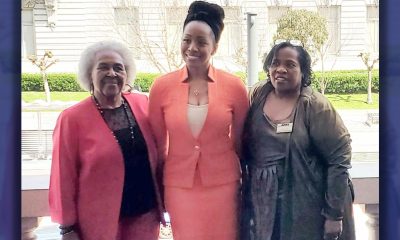#NNPA BlackPress
OP-ED: FDA — Smoking While Black and Brown in America
NNPA NEWSWIRE — Our experiences inform us that the implementation of a menthol ban will inevitably and undoubtedly create an increased number of stops, frisks, and interactions between law enforcement and members from Black and Brown communities. According to the Prison Policy Initiative, Black and Brown residents in the U.S. continue to have a long and troubled legacy of disproportionately larger numbers of police stops and interactions with the police. The proposed menthol ban will do nothing to quell this troubling reality.
The post OP-ED: FDA — Smoking While Black and Brown in America first appeared on BlackPressUSA.

By Dr. Benjamin F. Chavis, President and CEO, National Newspaper Publishers Association
Whenever the history of racial discrimination in the United States appears to repeat itself, it produces predictable rhymes and sometimes tragic social consequences. Mark Twain, Ida B. Wells, James Baldwin, and Toni Morrison all had one thing in common as visionary authors. They used their pens to offer literary critiques about America’s historical inflection points concerning racism and systemic inequalities.
The federal government’s recent announcement that it is close to proscribing a ban on menthol cigarettes is another public policy gone astray that will produce unintended racial-discriminatory consequences. As a result of a decades-long marketing campaign aimed at African Americans, nearly 85% of all non-Hispanic Black smokers choose menthol cigarettes, the highest percentage of menthol cigarette use compared to other racial and ethnic groups. The Federal Food and Drug Administration (FDA) should be questioned about their disparate targeting of African American and Latino-American smokers who disproportionately prefer to smoke menthol cigarettes. This is an urgent matter now that the FDA has just asked the government’s Office of Management and Budget (OMB) to review the proposed discriminatory ban.
Driving while Black and Brown, jogging while Black and Brown, and breathing while Black and Brown have had, at times, fatal consequences intergenerationally for women, men, and youth from our communities. Now, our families and communities will have to contend additionally with smoking while Black and Brown in America.
For the record, I do not smoke tobacco or marijuana. I am raising questions, however, to the FDA and to the U.S. Congress because I care passionately about protecting the civil rights and cultural rights of communities of color. We should learn from the past about how to avoid racial injustice rather than to entertain the repetition of pseudo-justifications of wrongdoing and counterproductive public policies that disparage communities of color.
Recalling back in the 1980s and 1990s there was the prevalence of the availability and use of crack cocaine that swept severe drug-related suffering in urban areas across the nation. Because of decades of White flight and self-segregation, those same inner-city areas were disproportionately populated by Black and Brown families. The result was another regrettable chapter in American history when crack cocaine ravaged our communities.
The subsequent response from the federal government was neither compassion nor empathy. Rather, the U.S. Congress passed the now-infamous 1994 Crime Bill, which treated the possession of crack cocaine disproportionately harsher in the criminal justice system than powder cocaine, which was more expensive and more commonly used by White drug users. Too many communities of color were once again devastated by the unjust massive long-term imprisonment of crack cocaine users for decades that literally destroyed families and left hundreds of thousands of children without parents while escalating mass incarceration of Black and Brown people to an unprecedented national level.
It is, therefore, against this historical backdrop that we find anew the recent contradictory announcement by the Biden Administration’s FDA. According to the Centers for Disease Control, over 85% of Black and Brown smokers prefer menthol cigarettes. While there may be compelling public health concerns that can be cited to support proposing a ban on smoking cigarettes, the question arises why the FDA only wants to target and ban “menthol” cigarettes that are disproportionately used and preferred by Black and Brown smokers. Law enforcement agencies, similar to what happened by law enforcement in response to the crack cocaine epidemic, will ultimately have to enforce the proposed ban on the sale of menthol cigarettes.
In addition, serious concerns today abound among national and local law enforcement leaders that a prohibition of these particular tobacco products will only end up dramatically increasing an illicit, underground market for these menthol products. I am certain that the U.S. Department of Homeland Security will rightly oppose any public policy by the FDA that will lead to further substantial border insecurity from the future billion-dollar illicit smuggling of proposed menthol-banned tobacco products into the United States. Another serious unintended consequence will be the illegal trafficking of FDA-banned cigarettes by international terrorists who will profit millions of dollars from that illicit trade.
I write, therefore, on behalf of the National Newspaper Publishers Association (NNPA) and the Black Press of America that have been “pleading our own cause” since March 16, 1827 with the first publication of Freedom’s Journal 195 years ago. Our concerns are not hypothetical and do not exist in a vacuum.
Our experiences inform us that the implementation of a menthol ban will inevitably and undoubtedly create an increased number of stops, frisks, and interactions between law enforcement and members from Black and Brown communities. According to the Prison Policy Initiative, Black and Brown residents in the U.S. continue to have a long and troubled legacy of disproportionately larger numbers of police stops and interactions with the police. The proposed menthol ban will do nothing to quell this troubling reality.
Moreover, there is data to suggest that a prohibition on the sale of menthol cigarettes would not meet the proposed ban’s intended goal. According to a report by the United States Surgeon General, published in 2020, “the evidence is suggestive but not sufficient to infer that restricting the sale of certain types of tobacco products, such as menthol or other flavored products, increases smoking cessation, especially among certain populations.” Indeed, a report by the National Bureau of Economic Research echoes this concern and suggests that a prohibition on menthol cigarettes is “unlikely to be a panacea,” because while the product may be prohibited in Canada, it is available on Native Canadian reserves, and still available for purchase throughout Mexico.
On his first day in The White House, President Biden signed the Executive Order (13985) on Advancing Racial Equity and Support for Underserved Communities Through the Federal Government. That was a much-needed federal corrective action taken by President Biden. Notwithstanding those facts, it has become a noticeable contradiction for the FDA to now embark on a Notice of Proposed Rulemaking (NPRM) with respect to a menthol ban tentatively scheduled for April 2022.
What are some of the possible alternative options for the FDA and for the U.S. Congress with respect to menthol cigarettes? One option is for the Secretary of Health and Human Services, acting through the Commissioner of the FDA to enter into an agreement with the National Academies of Sciences, Engineering and Medicine, and additional relevant entities (including representatives of community organizations that have been historically underrepresented in the Federal Government and underserved by, subject to discrimination in, Federal policies and programs) to conduct a national study on the impact of a menthol ban would have on:
- the frequency of adverse law enforcement interactions with members of communities of color, underserved and other discriminated communities
- the illicit sale of counterfeit cigarettes in communities of color, underserved and other discriminated communities, and
- the likelihood that counterfeit cigarettes illicitly sold in communities of color, underserved and other discriminated communities would contain a mixture of lethal substances in excess of the toxins found in ordinary commercially approved cigarettes
There are other options in addition to the stated above proposal that I am confident can and should be explored by both the U.S. Congress and the FDA. What should be prohibited at this point should be all forms of racial profiling and targeting. Smoking while Black and Brown should not be the predicate for more negative disastrous interactions between law enforcement and our communities who have already suffered too much. I recently had the honor to attend a national meeting of the National Organization of Black Law Enforcement Executives (NOBLE) in Baton Rouge, Louisiana. Black police chiefs and other Black law enforcement executives from across the nation voiced their concerns about the negative, disparate and dangerous unintended consequences of the proposed FDA ban on menthol cigarettes.
Dr. Benjamin F. Chavis, Jr. is currently the President and CEO of the National Newspaper Publishers Association (NNPA) and Executive Producer/Host of The Chavis Chronicles television show that is broadcast weekly on PBS TV stations throughout the United States.
The post OP-ED: FDA — Smoking While Black and Brown in America first appeared on BlackPressUSA.
#NNPA BlackPress
Beloved Actor and Activist Louis Cameron Gossett Jr. Dies at 87
NNPA NEWSWIRE — Louis Gossett Jr., the groundbreaking actor whose career spanned over five decades and who became the first Black actor to win an Academy Award as Best Supporting Actor for his memorable role in “An Officer and a Gentleman,” has died. Gossett, who was born on May 27, 1936, in Brooklyn, N.Y., was 87. Recognized early on for his resilience and nearly unmatched determination, Gossett arrived in Los Angeles in 1967 after a stint on Broadway.
The post Beloved Actor and Activist Louis Cameron Gossett Jr. Dies at 87 first appeared on BlackPressUSA.

By Stacy M. Brown
NNPA Newswire Senior National Correspondent
@StacyBrownMedia
Louis Gossett Jr., the groundbreaking actor whose career spanned over five decades and who became the first Black actor to win an Academy Award as Best Supporting Actor for his memorable role in “An Officer and a Gentleman,” has died. Gossett, who was born on May 27, 1936, in Brooklyn, N.Y., was 87. Recognized early on for his resilience and nearly unmatched determination, Gossett arrived in Los Angeles in 1967 after a stint on Broadway.
He sometimes spoke of being pulled over by law enforcement en route to Beverly Hills, once being handcuffed to a tree, which he remembered as a jarring introduction to the racial tensions of Hollywood. In his memoir “An Actor and a Gentleman,” Gossett recounted the ordeal, noting the challenges faced by Black artists in the industry. Despite the hurdles, Gossett’s talent shone brightly, earning him acclaim in groundbreaking productions such as “A Raisin in the Sun” alongside Sidney Poitier. His Emmy-winning portrayal of Fiddler in “Roots” solidified his status as a trailblazer, navigating a landscape fraught with racial prejudice.
According to the HistoryMakers, which interviewed him in 2005, Gossett’s journey into the limelight began during his formative years at PS 135 and Mark Twain Junior High School, where he demonstrated early leadership as the student body president. His passion for the arts blossomed when he starred in a “You Can’t Take It With You” production at Abraham Lincoln High School, catching the attention of talent scouts who propelled him onto Broadway’s stage in “Take A Giant Step.” His stellar performance earned him the prestigious Donaldson Award for Best Newcomer to Theatre in 1952. Though initially drawn to sports, Gossett’s towering 6’4” frame and athletic prowess led him to receive a basketball scholarship at New York University. Despite being drafted by the New York Knicks in 1958, Gossett pursued his love for acting, honing his craft at The Actors Studio under the tutelage of luminaries like John Sticks and Peggy Fury.
In 1961, Gossett’s talent caught the eye of Broadway directors, leading to roles in acclaimed productions such as “Raisin in the Sun” and “The Blacks,” alongside legends like James Earl Jones, Cicely Tyson, Roscoe Lee Brown, and Maya Angelou. Transitioning seamlessly to television, Gossett graced small screens with appearances in notable shows like “The Bush Baby” and “Companions in Nightmare.” Gossett’s silver screen breakthrough came with his role in “The Landlord,” paving the way for a prolific filmography that spanned over 50 movies and hundreds of television shows. From “Skin Game” to “Lackawanna Blues,” Gossett captivated audiences with his commanding presence and versatile performances.
However, his portrayal of “Fiddler” in Alex Haley’s groundbreaking miniseries “Roots” earned Gossett critical acclaim, including an Emmy Award. The HistoryMakers noted that his golden touch extended to the big screen, where his role as Sergeant Emil Foley in “An Officer and a Gentleman” earned him an Academy Award for Best Supporting Actor, making him a trailblazer in Hollywood history.
Beyond the glitz and glamour of Hollywood, Gossett was deeply committed to community activism. In 1964, he co-founded a theater group for troubled youth alongside James Earl Jones and Paul Sorvino, setting the stage for his lifelong dedication to mentoring and inspiring the next generation. Gossett’s tireless advocacy for racial equality culminated in the establishment of Eracism, a nonprofit organization dedicated to combating racism both domestically and abroad. Throughout his illustrious career, Gossett remained a beacon of strength and resilience, using his platform to uplift marginalized voices and champion social change. Gossett is survived by his children, Satie and Sharron.
The post Beloved Actor and Activist Louis Cameron Gossett Jr. Dies at 87 first appeared on BlackPressUSA.
#NNPA BlackPress
COMMENTARY: D.C. Crime Bill Fails to Address Root Causes of Violence and Incarceration
WASHINGTON INFORMER — The D.C. crime bill and so many others like it are reminiscent of the ‘94 crime bill, which produced new and harsher criminal sentences, helped deploy thousands of police and surveilling methods in Black and brown communities, and incentivized more states to build prisons through a massive infusion of federal funding. While it is not at the root of mass incarceration, it significantly accelerated it, forcing a generation of Black and brown families into a never-ending cycle of state-sanctioned violence and incarceration.
The post COMMENTARY: D.C. Crime Bill Fails to Address Root Causes of Violence and Incarceration first appeared on BlackPressUSA.

By Kaili Moss and Jillian Burford | Washington Informer
Mayor Bowser has signed the “Secure DC” omnibus bill passed by the D.C. Council last month. But we already know that this bill will be disastrous for all of D.C., especially for Black and brown residents.
While proponents claim that this legislation “will make D.C. residents safer and more secure,” it actually does nothing to address the root of the harm in the first place and instead maintains a cycle of violence, poverty, and broken community ties. The omnibus bill calls for increased surveillance, drug-free zones, and will expand pre-trial detention that will incarcerate people at a significantly higher rate and for an indeterminate amount of time before they are even tried. This bill will roll back decades of nationwide policy reform efforts and initiatives to keep our communities safe and whole, which is completely contradictory to what the “Secure” D.C. bill claims it will do.
What is unfolding in Washington, D.C., is part of a dangerous national trend. We have seen a resurrection of bad crime bills in several jurisdictions across the country — a phenomenon policy experts have named “zombie laws,” which are ineffective, costly, dangerous for communities of color and, most importantly, will not create public safety. Throwing more money into policing while failing to fund preventative measures does not keep us safe.
The D.C. crime bill and so many others like it are reminiscent of the ‘94 crime bill, which produced new and harsher criminal sentences, helped deploy thousands of police and surveilling methods in Black and brown communities, and incentivized more states to build prisons through a massive infusion of federal funding. While it is not at the root of mass incarceration, it significantly accelerated it, forcing a generation of Black and brown families into a never-ending cycle of state-sanctioned violence and incarceration. Thirty years later, despite spending billions each year to enforce these policies with many of these provisions remaining in effect, it has done very little to create long-term preventative solutions. Instead, it placed a permanent moving target on the backs of Black people, and the D.C. crime bill will do the same.
The bill calls for more pretrial detention. When our loved ones are held on pretrial detention, they are held on the presumption of guilt for an indeterminate amount of time before ever seeing a judge, which can destabilize people and their families. According to experts at the Malcolm Weimer Center for Social Policy at Harvard University, just one day in jail can have “devastating consequences.” On any given day, approximately 750,000 people are held in jails across the nation — a number that beats our nation’s capital population by about 100,000. Once detained, people run the risk of losing wages, jobs, housing, mental and health treatments, and time with their families. Studies show that pretrial detention of even a couple of days makes it more likely for that person to be rearrested.
The bill also endangers people by continuing a misguided and dangerous War on Drugs, which will not get drugs off the street, nor will it deter drug use and subsequent substance use disorders (SUDs). Drug policies are a matter of public health and should be treated as such. Many states such as Alabama, Iowa and Wisconsin are treating the current fentanyl crisis as “Crack 2.0,” reintroducing a litany of failed policies that have sent millions to jails and prisons instead of prioritizing harm reduction. Instead, we propose a simple solution: listen to members of the affected communities. Through the Decrim Poverty D.C. Coalition, community members, policy experts and other stakeholders formed a campaign to decriminalize drugs and propose comprehensive legislation to do so.
While there are many concerning provisions within the omnibus bill, car chases pose a direct physical threat to our community members. In July 2023, NBC4 reported that the D.C. Council approved emergency legislation that gave MPD officers the ability to engage in vehicular pursuits with so-called “limited circumstances.” Sgt. Val Barnes, the head of MPD’s carjacking task force, even expressed concern months before the decision, saying, “The department has a pretty strict no-chase policy, and obviously for an urban setting and a major metropolitan city, that’s understandable.” If our law enforcement officers themselves are operating with more concern than our elected officials, what does it say about the omnibus bill’s purported intention to keep us safe?
And what does it mean when the risk of bodily harm is posed by the pursuit itself? On Saturday, Feb. 10, an Eckington resident had a near-miss as a stolen car barreled towards her and her dog on the sidewalk with an MPD officer in pursuit. What responsibility does the city hold if this bystander was hit? What does restitution look like? Why are our elected officials pushing for MPD officers to contradict their own policies?
Just a few summers ago during the uprisings of 2020, we saw a shift in public perspectives on policing and led to legislation aimed at limiting police power after the highly-publicized murders of loved ones Breonna Taylor and George Floyd — both victims of War on Drugs policing and the powers gained from the ’94 crime bill. And yet here we are. These measures do not keep us safe and further endanger the health of our communities. Studies show that communities that focus on harm reduction and improving material conditions have a greater impact on public safety and community health. What’s missing in mainstream conversations about violent crime is the violence that stems from state institutions and structures that perpetuate racial and class inequality. The people of D.C. deserve to feel safe, and that includes feeling safe from the harms enacted by the police.
Kaili Moss is a staff attorney at Advancement Project, a national racial justice and legal organization, and Jillian Burford is a policy organizer at Harriet’s Wildest Dreams.
The post COMMENTARY: D.C. Crime Bill Fails to Address Root Causes of Violence and Incarceration first appeared on BlackPressUSA.
#NNPA BlackPress
Mayor, City Council President React to May 31 Closing of Birmingham-Southern College
THE BIRMINGHAM TIMES — “This is a tragic day for the college, our students, our employees, and our alumni, and an outcome so many have worked tirelessly to prevent,” Rev. Keith Thompson, chairman of the BSC Board of Trustees said in an announcement to alumni. “We understand the devastating impact this has on each of you, and we will now direct our efforts toward ensuring the smoothest possible transition for everyone involved.”
The post Mayor, City Council President React to May 31 Closing of Birmingham-Southern College first appeared on BlackPressUSA.

By Barnett Wright | The Birmingham Times
Birmingham-Southern College will close on May 31, after more than a century as one of the city’s most respected institutions.
“This is a tragic day for the college, our students, our employees, and our alumni, and an outcome so many have worked tirelessly to prevent,” Rev. Keith Thompson, chairman of the BSC Board of Trustees said in an announcement to alumni. “We understand the devastating impact this has on each of you, and we will now direct our efforts toward ensuring the smoothest possible transition for everyone involved.”
There are approximately 700 students enrolled at BSC this semester.
“Word of the decision to close Birmingham Southern College is disappointing and heartbreaking to all of us who recognize it as a stalwart of our community,” Birmingham Mayor Randall Woodfin said in a statement. “I’ve stood alongside members of our City Council to protect this institution and its proud legacy of shaping leaders. It’s frustrating that those values were not shared by lawmakers in Montgomery.”
Birmingham City Council President Darrell O’Quinn said news of the closing was “devastating” on multiple levels.
“This is devastating for the students, faculty members, families and everyone affiliated with this historic institution of higher learning,” he said. “It’s also profoundly distressing for the surrounding community, who will now be living in close proximity to an empty college campus. As we’ve seen with other institutions that have shuttered their doors, we will be entering a difficult chapter following this unfortunate development … We’re approaching this with resilience and a sense of hope that something positive can eventually come from this troubling chapter.”
The school first started as the merger of Southern University and Birmingham College in 1918.
The announcement comes over a year after BSC officials admitted the institution was $38 million in debt. Looking to the Alabama Legislature for help, BSC did not receive any assistance.
This past legislative session, Sen. Jabo Waggoner sponsored a bill to extend a loan to BSC. However, the bill subsequently died on the floor.
Notable BSC alumni include former New York Times editor-in-chief Howell Raines, former U.S. Sen. Howell Heflin and former Alabama Supreme Court Chief Justice Perry O. Hooper Sr.
This story will be updated.
The post Mayor, City Council President React to May 31 Closing of Birmingham-Southern College first appeared on BlackPressUSA.
-

 Activism4 weeks ago
Activism4 weeks agoOakland Post: Week of March 27 – April 2, 2024
-

 #NNPA BlackPress4 weeks ago
#NNPA BlackPress4 weeks agoCOMMENTARY: D.C. Crime Bill Fails to Address Root Causes of Violence and Incarceration
-

 #NNPA BlackPress4 weeks ago
#NNPA BlackPress4 weeks agoFrom Raids to Revelations: The Dark Turn in Sean ‘Diddy’ Combs’ Saga
-

 #NNPA BlackPress4 weeks ago
#NNPA BlackPress4 weeks agoCOMMENTARY: Lady Day and The Lights!
-

 #NNPA BlackPress4 weeks ago
#NNPA BlackPress4 weeks agoMayor, City Council President React to May 31 Closing of Birmingham-Southern College
-

 #NNPA BlackPress4 weeks ago
#NNPA BlackPress4 weeks agoBaltimore Key Bridge Catastrophe: A City’s Heartbreak and a Nation’s Alarm
-

 #NNPA BlackPress4 weeks ago
#NNPA BlackPress4 weeks agoBaltimore’s Key Bridge Struck by Ship, Collapses into Water
-

 #NNPA BlackPress4 weeks ago
#NNPA BlackPress4 weeks agoBeloved Actor and Activist Louis Cameron Gossett Jr. Dies at 87

















































